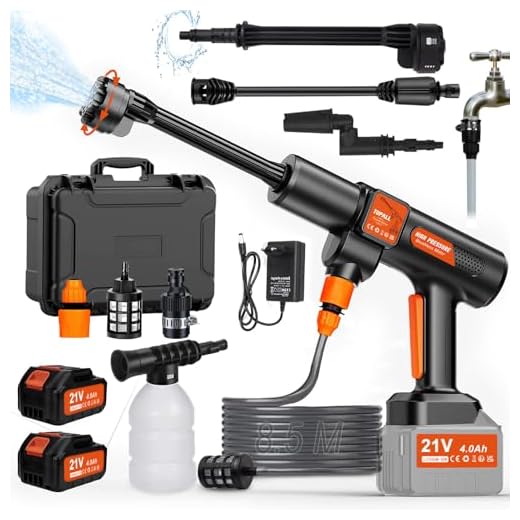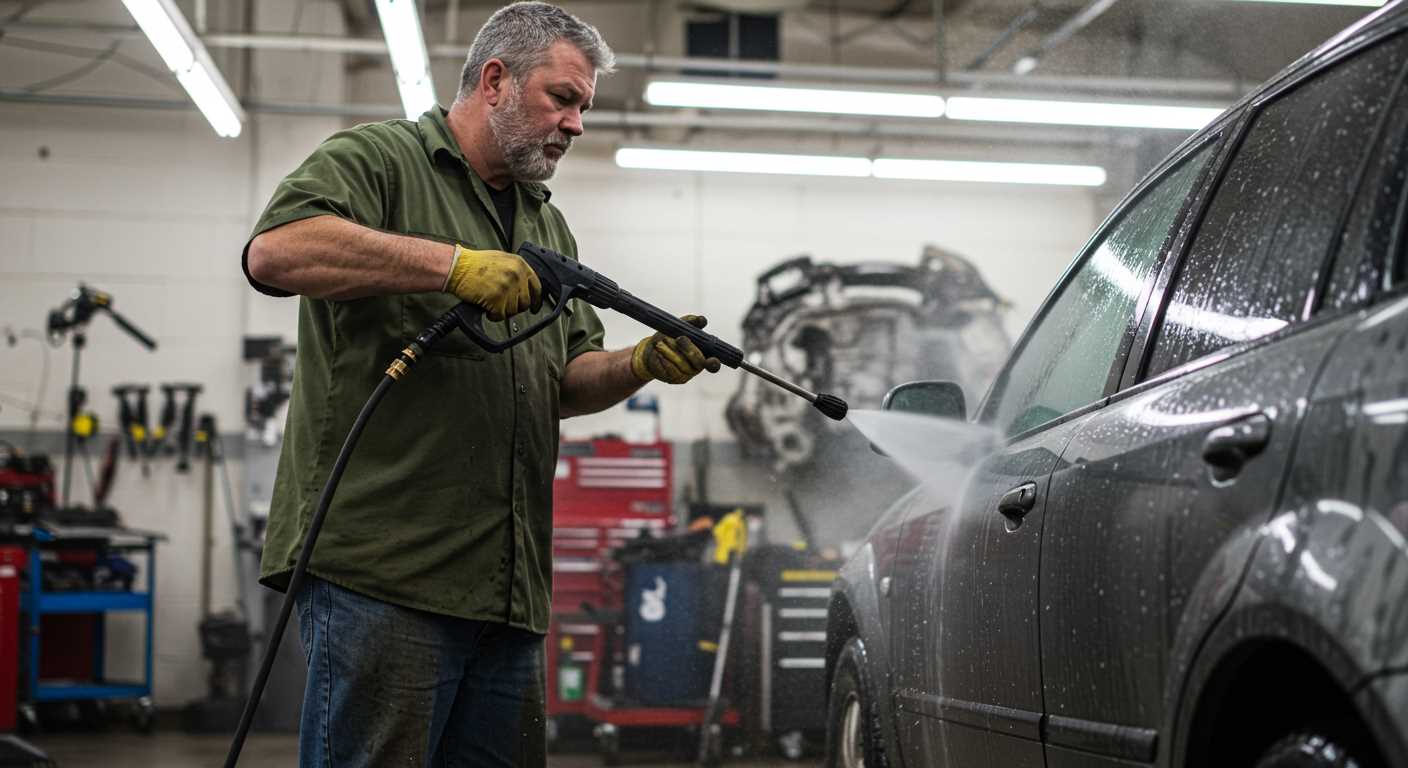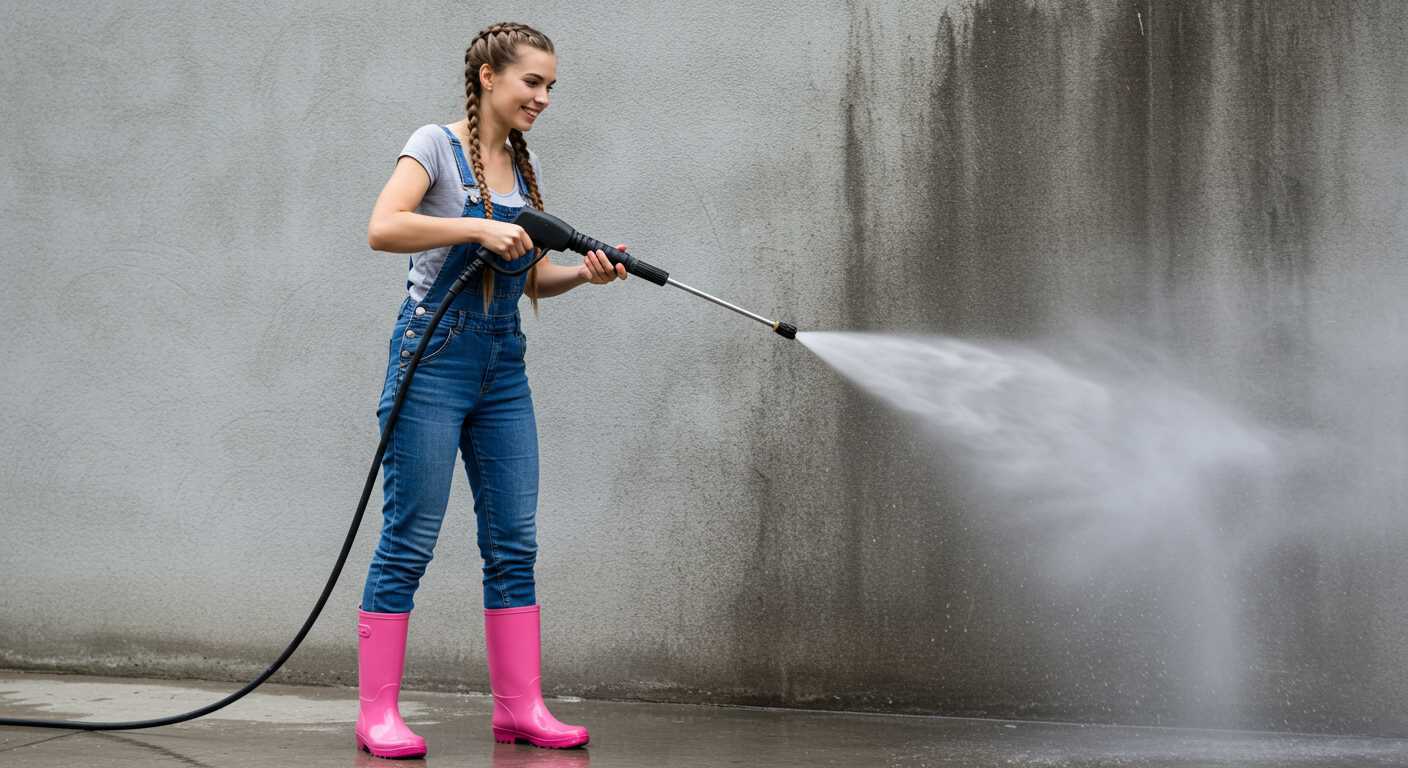



For optimal vehicle cleaning, a 25-degree nozzle is my go-to choice. This attachment strikes a perfect balance, providing sufficient power to lift grime without risking damage to sensitive surfaces like paint and glass. The fan-shaped spray pattern disperses water effectively, ensuring thorough coverage of the entire vehicle body.
In addition, using a low-pressure soap nozzle can be beneficial when applying car wash detergent. This attachment allows for a gentle application, which aids in lifting stubborn dirt while minimising the risk of causing harm to the finish. Combining this with a sturdy rinse afterwards will leave your vehicle spotless.
Always remember to maintain a safe distance from the vehicle–typically around 2 to 3 feet–while using these attachments. This distance helps to prevent any potential damage from excessive force. When it comes to cleaning different parts of your vehicle, adjusting the angle of the nozzle to target harder-to-reach areas will enhance the overall result.
Choosing the Right Adapter for Vehicle Cleaning
The ideal attachment for cleaning vehicles is typically the 25-degree fan pattern. This choice strikes a balance between effective dirt removal and the safety of your vehicle’s paintwork.
Additional Options Based on Specific Tasks
- 15-degree Adapter: Best for stubborn grime and heavy mud, but caution is needed to avoid damage to the paint.
- 40-degree Adapter: Suitable for rinsing or gentle cleaning; it disperses water over a wider area, which is perfect for delicate surfaces.
- Soap Dispensing Attachment: Utilizing this alongside your vehicle-cleaning head ensures that you can apply cleaning solutions effectively without risk of damage.
Important Techniques for Optimal Results
- Maintain Distance: Keep the attachment about two feet from the surface to prevent any potential scratches.
- Angle of Application: Position the spray in a downward direction for effective rinsing without pushing dirt around.
- Test Before Full Application: Always test on a small, inconspicuous area before starting on the entire vehicle.
Selecting the correct attachment is crucial to both cleaning efficiency and the protection of your vehicle’s finish. Always prioritise gentle yet effective cleaning techniques to preserve its appearance.
Understanding Nozzle Types

Selection of the right attachment can significantly enhance the cleaning outcome. There are four primary types to consider:
- 0-degree: Delivers a narrow, high-pressure stream, effective for tough grime but can damage delicate surfaces.
- 15-degree: Slightly wider spray, suitable for heavy-duty tasks like stripping paint and removing stubborn dirt.
- 25-degree: A versatile option for general cleaning, ideal for surfaces such as siding and driveways.
- 40-degree: Produces a wide fan spray, great for light-duty work and washing vehicles without risking damage.
Selecting the Right Type
To maximise cleaning efficiency and protect your vehicle, I suggest focusing on the 25-degree and 40-degree attachments. The 25-degree is your go-to for dirt removal, while the 40-degree is excellent for rinsing off soap without any risk to the paintwork.
Additionally, consider factors like distance from the surface and water flow. Maintaining an optimal distance will prevent damage and ensure thorough cleaning. Experiment with settings to determine what suits your needs best.
Best Nozzle Size for Car Paint Protection
The ideal size to safeguard automotive paint is typically between 25° and 40°. A nozzle with a wider spray angle disperses water over a larger area, reducing the likelihood of damage to the surface. I recommend starting with a 40° head for pre-washing and rinsing, as it applies a gentle mist that helps to loosen dirt and debris without aggressive force.
Why 25° and 40°?
The 25° option is perfect for tougher grime and contaminants, providing adequate power while still prioritising the integrity of the paint. Conversely, the 40° variant offers a more delicate touch, ideal for final rinsing or when applying waxes and sealants. Both sizes assist in effectively removing dirt without compromising the lacquer or clear coat finish.
Comparison Table of Nozzle Sizes

| Angle | Use Case | Recommended Distance |
|---|---|---|
| 25° | Heavy grime removal | 1-2 feet |
| 40° | Final rinse or waxing | 2-3 feet |
Maintaining distance from the vehicle is crucial, as being too close can lead to unintentional scratches and damage. With the right angle and careful handling, you can effectively protect the finish of your vehicle while achieving an impressive clean.
Choosing the Right Spray Angle for Different Areas
Use a 25-degree spray angle when cleaning the main body of the vehicle. This angle strikes a balance, providing enough coverage without risking damage to the paintwork. I recommend keeping a distance of about two feet to avoid concentrated pressure on delicate surfaces.
Wheels and Tires
For wheels and tyres, opt for a 15-degree angle. This is ideal for removing stubborn grime and brake dust. Approach these areas with caution, getting close for intensity without causing abrasion to the wheel finishes.
Windows and Glass
When it comes to glass surfaces, a 40-degree angle is perfect. This wider spray ensures that water reaches the entire area without excessive force, safeguarding the glass and seals. Be sure to maintain a distance of at least three feet to facilitate an effective clean without risk of shattering or stress on the seals.
Choosing the right angle for each vehicle area not only enhances cleaning efficiency but also protects its surfaces from potential damage.
How Nozzle Colour Codes Indicate Pressure Levels
Understanding colour codes on tips helps in selecting the correct attachment for various tasks. Each hue corresponds to a specific spray angle and force, providing guidance on suitable applications.
Red tips, known for their 0-degree spray angle, emit a concentrated stream ideal for stubborn stains, though using them demands caution to avoid damaging surfaces. Yellow tips, with a 15-degree angle, deliver a more controlled spray effective for tough grime without being overly aggressive.
Green tips provide a 25-degree spread and are versatile for general cleaning tasks. They strike a balance, allowing for thorough cleansing while minimizing risks to delicate finishes. For softer applications, white tips, featuring a 40-degree angle, disperse water widely, perfect for rinsing sensitive areas without causing harm.
Utilising colour-coded systems simplifies identifying the appropriate level of force needed. It’s prudent to match the right hue with intended tasks, ensuring effective cleaning while safeguarding surfaces against potential damage.
When to Use a Foam Cannon Attachment
Utilising a foam cannon attachment is highly recommended during the initial cleaning phase. This device mixes soap with water, creating a thick foam that clings to surfaces, effectively loosening dirt and grime. Apply it generously to the entire exterior, allowing the solution to dwell for a few minutes for optimal results.
Choose a high-quality snow foam detergent, specifically formulated for automotive surfaces. This ensures compatibility and maximises cleaning efficiency while remaining safe for paintwork. Make sure the attachment is compatible with the model of spraying equipment being used; check the specifications if unsure.
In situations where there is heavy contamination or stubborn stains, opt for a foam cannon rather than direct force. The foam serves as a buffer, preventing potential scratches while lifting contaminants away. This is particularly useful for areas like wheel arches or lower body panels, where grime accumulates more intensely.
For routine washing, a foam cannon can significantly enhance the cleaning process, reducing the need for vigorous scrubbing and ensuring a thorough wash without risking damage to the vehicle’s finish. It’s my go-to method for maintaining a clean and shiny exterior.
Tips for Avoiding Damage While Washing Your Vehicle

Always maintain a safe distance between the cleaning tool and the surface of the paint. A separation of at least 18 inches is recommended to prevent any chance of chipping or stripping. This distance helps to distribute the force more evenly and reduces the risk of damage.
Before commencing, ensure the paintwork is not overly hot. Direct sunlight can elevate the temperature of the surface, making the paint more susceptible to damage. Opt for a shaded area or wash during cooler hours.
Utilise a low-flow attachment if available, as this reduces the force exerted while still effectively removing dirt and grime. Whenever possible, combine washing methods: start with a foam cannon for pre-soaking, followed by a gentler rinse to minimise the risk of scratching.
Inspect the surface for any chips, scratches, or imperfections before starting the cleaning process. Areas needing extra caution should be addressed with care to avoid exacerbating existing damage.
Pay attention to areas near the trim and decals, as water intrusion can lift these components. Use a more controlled technique in those places to prevent dislodging or damaging them.
After rinsing, utilise a soft microfibre cloth for drying to avoid swirl marks and scratches. Avoid using a conventional garden hose for the rinse, as it may not provide an adequate or controlled flow.
Practicing these methods will significantly protect the finish of your vehicle while ensuring it stays looking its best. Experience and attention to detail are paramount when maintaining your vehicle’s appearance.
Maintenance Advice for Pressure Washer Nozzles
To ensure longevity and optimal performance of spray attachments, regularly clean them after each session. Dirt, grime or residues can block the openings, diminishing efficiency. Rinse nozzles thoroughly with clean water to remove any debris.
Store the units in a dry location, away from extreme temperatures. Exposure to moisture or heat can degrade materials, leading to cracks or malfunctions. Keeping them in protective cases can provide added safeguard against damage.
Check for wear and tear periodically. Examine seals and O-rings for cracks or deterioration, which can lead to leaks. Replacing these components can often restore functionality without needing to invest in new spray equipment.
Calibration is crucial. Over time, a nozzle may lose its original spray pattern. Test the angles and flow to ensure they meet the required specifications. This helps avoid issues like uneven cleaning or paint damage.
Use the appropriate tools when attaching or detaching nozzles. Hand-tightening is usually sufficient; excessive force can strip threads or break fittings. This simple practice can prolong the lifespan of your attachments considerably.
Learn to recognise when replacements are necessary. If you notice reduced performance or visible damage, it’s time to consider new units. Investing in high-quality spares can make a significant difference in cleaning results.
Finally, always consult the manufacturer’s guide for maintenance specifics. Each model may have unique requirements that, if adhered to, can keep your cleaning sessions efficient and effective.
FAQ:
What type of nozzle is best for washing my car with a pressure washer?
The best nozzle for washing your car is typically the 25-degree green nozzle. This nozzle provides a good balance of pressure and width, allowing you to clean effectively without risking damage to the vehicle’s paint. It is suitable for removing dirt and grime while being gentle enough to protect delicate surfaces.
Is a higher pressure nozzle always better for washing cars?
No, a higher pressure nozzle is not always better for washing cars. Using a nozzle with too much pressure can damage the car’s paint and can cause issues with trim and seals. It’s important to choose a nozzle that offers appropriate pressure for cleaning without causing harm. Generally, a 25-degree or 40-degree nozzle is recommended for safe washing.
Can I use a turbo nozzle for washing my car?
Using a turbo nozzle on your car is not recommended. Turbo nozzles combine high pressure and a rotating jet, which can be too aggressive for car surfaces. This might lead to scratches or chips in the paintwork. It is better to stick with a lower pressure nozzle, such as the 25-degree or 40-degree ones, for safe and effective cleaning.
What should I consider when selecting a nozzle for my pressure washer?
When selecting a nozzle for your pressure washer, consider the degree of the nozzle, which affects the spray pattern. Lower degrees (like 0 or 15 degrees) produce a focused, high-pressure stream suitable for stubborn stains, while higher degrees (25 or 40) create a wider spray that is gentler on surfaces. Additionally, check the specifications of your pressure washer to ensure compatibility with the nozzles you choose. It’s also wise to consider the type of dirt or grime on your vehicle—more delicate surfaces require gentler spray options.
How do I avoid damaging my car’s paint while using a pressure washer?
To avoid damaging your car’s paint while using a pressure washer, choose a nozzle with a wider spray angle, such as a 25-degree or 40-degree nozzle. Maintain a safe distance between the nozzle and the vehicle—ideally around 2-3 feet. Start rinsing from the top of the car to the bottom and avoid concentrating the jet on one spot for too long. Additionally, ensure that the pressure setting on the washer is appropriate for vehicle cleaning to prevent any paint damage.









